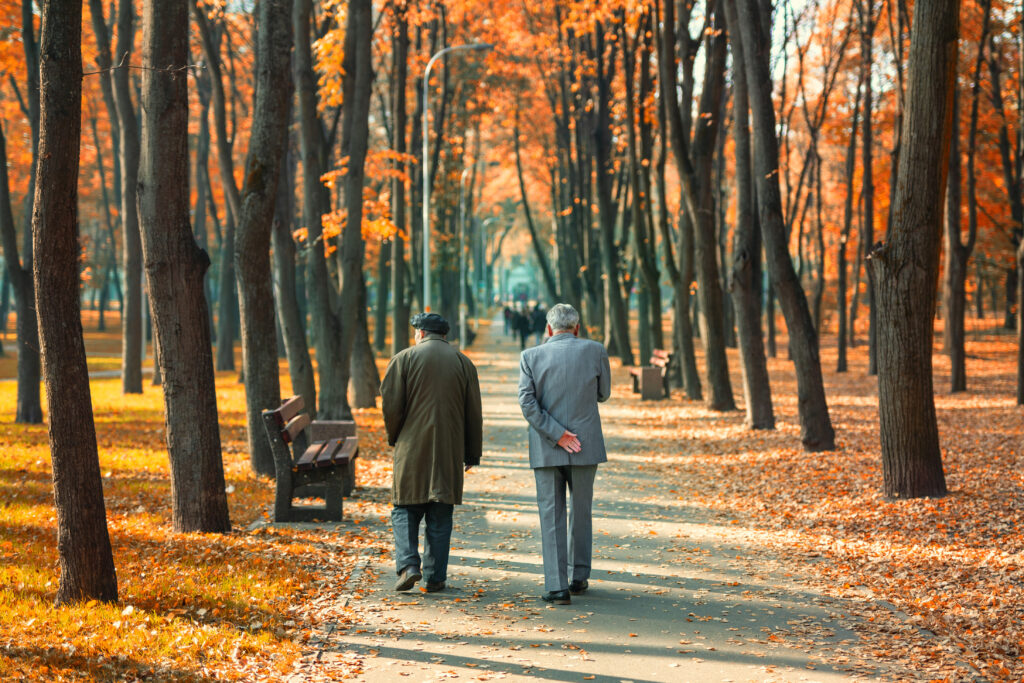What is the “Dementia Walk”?
“Dementia walk” is a term sometimes used to describe a type of gait, or walking pattern, that is commonly observed in individuals with dementia. This walking pattern is often slower and characterized by shorter steps that are more variable and asymmetric. Additionally, individuals with dementia may spend longer periods of time with both feet on the ground during the walking cycle.
The term “dementia walk” is not a medically recognized term, and it’s important to note that not all individuals with dementia will exhibit this specific walking pattern. However, changes in gait and mobility are common in individuals with dementia, and may be a symptom of the condition or related to other factors such as aging or physical impairments.

Why do Walks Change with Dementia?
Gait changes are a common feature of dementia and can have a significant impact on an individual’s overall mobility and quality of life. Several studies have examined the specific gait patterns seen in individuals with dementia, and the factors that contribute to these changes.
One of the most common gait changes observed in individuals with dementia is a slower walking speed. A study published in the Journal of Alzheimer’s Disease in 2014 found that individuals with Alzheimer’s disease had a significantly slower walking speed than age-matched controls, even after controlling for factors such as age, sex, and physical activity level (1). Slower walking speed has been associated with increased risk of falls, decreased physical activity, and poorer health outcomes in older adults (2).
In addition to slower walking speed, individuals with dementia may exhibit changes in their stride length and step width. A study published in the Journal of Geriatric Physical Therapy in 2019 found that individuals with dementia had a shorter stride length and wider step width than controls, indicating a more cautious walking pattern (3). Other studies have found that individuals with dementia may have a more variable stride length and step width, indicating less consistent and less stable gait patterns (4).
Asymmetric gait patterns, where the left and right sides of the body move differently during walking, are also commonly seen in individuals with dementia. A study published in the Journal of Alzheimer’s Disease in 2017 found that individuals with Alzheimer’s disease had significantly greater asymmetry in their gait patterns than controls, particularly in the stride length and step time variables (5).
Finally, individuals with dementia may spend more time with both feet on the ground during the walking cycle, a pattern known as “double support time.” A study published in the Journal of the American Geriatrics Society in 2014 found that individuals with dementia had a longer double support time than controls, indicating a more cautious and less efficient walking pattern (6).
Overall, gait changes in dementia are complex and multifactorial, and can be influenced by a variety of factors including age, cognitive impairment, physical impairments, and medication use. Studies have suggested that gait changes in dementia may be related to underlying brain pathology, including damage to areas of the brain involved in motor control and balance (7). More research is needed to fully understand the mechanisms underlying gait changes in dementia, and to develop effective interventions to address these changes and improve mobility and quality of life for individuals with the condition.
References:
- Montero-Odasso, M., Verghese, J., Beauchet, O., & Hausdorff, J. M. (2014). Gait and cognition: a complementary approach to understanding brain function and the risk of falling. Journal of Alzheimer’s Disease, 42(s3), S167-S175.
- Studenski, S., Perera, S., Patel, K., Rosano, C., Faulkner, K., Inzitari, M., … & Guralnik, J. (2011). Gait speed and survival in older adults. JAMA, 305(1), 50-58.
- Suttanon, P., Hill, K. D., Said, C. M., Logiudice, D., Lautenschlager, N. T., & Dodd, K. J. (2019). Differences in spatiotemporal gait parameters between those with mild cognitive impairment, Alzheimer’s disease and healthy older adults during level walking: a systematic review and meta-analysis.





